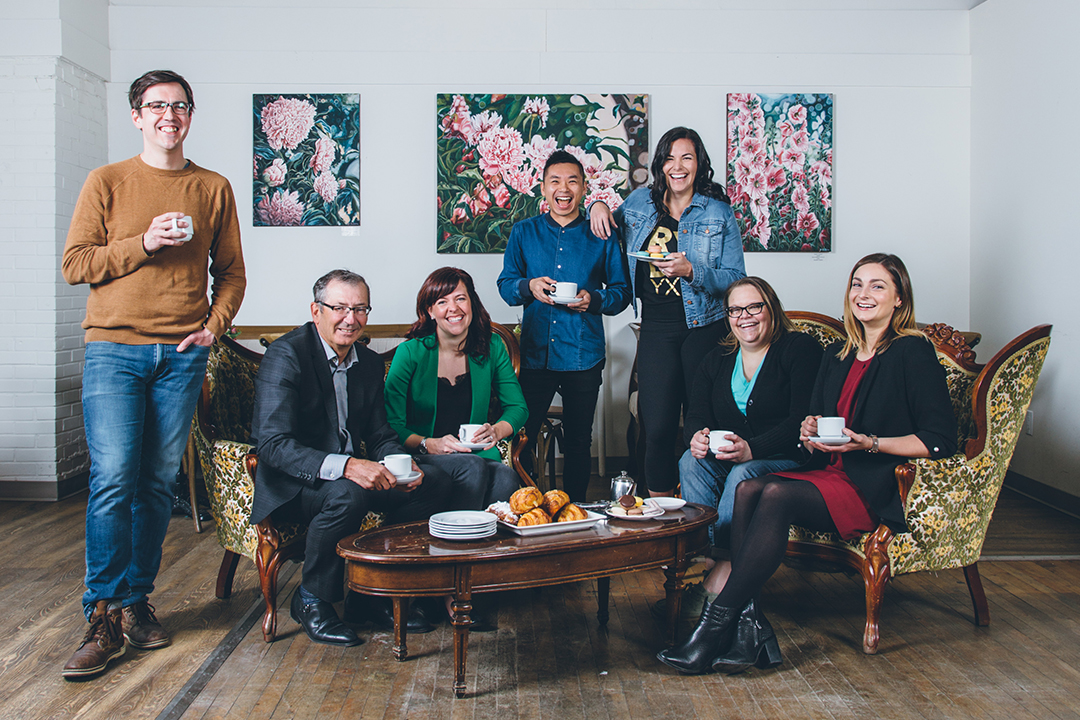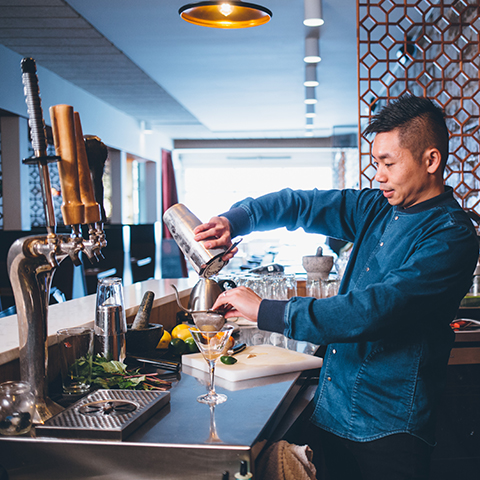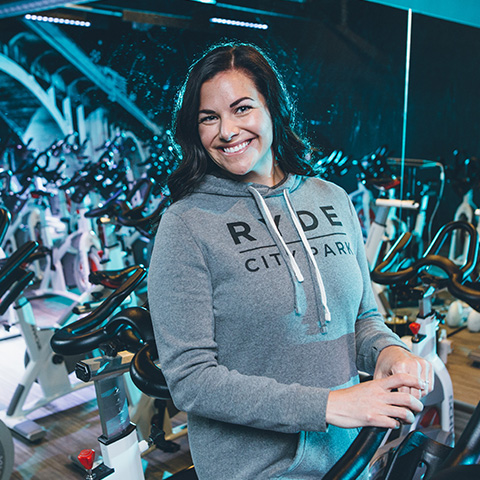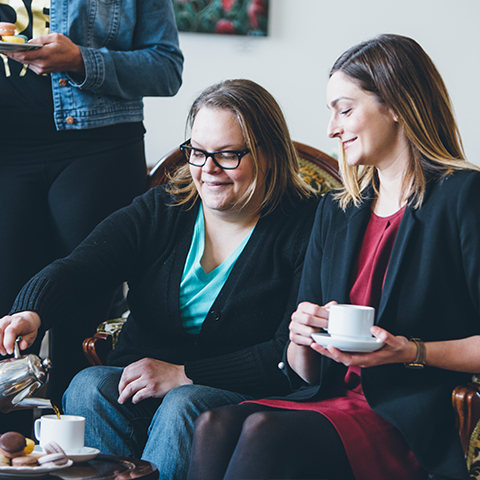
The Paris of the Prairies
There are ties that bind the U of S to Saskatoon and our nearly 39,000 alumni living here have a lot to do with it. U of S grads are leading the way in transforming this once small city into the destination it is today.
By ASHLYN GEORGETravel blogger and Saskatoon native Ashlyn George (BA’09, BEd’10) takes us on a trip through the bustling city and shares the stories of a few of Saskatoon’s movers and shakers.
Several times a month I can be found inside one of Saskatoon’s coffee shops. I use the spaces to network with other freelancers and entrepreneurs who also call the city’s cafés their unofficial workplace. In a career as a travel writer with a nomadic office that can sometimes feel isolating, it’s important I actively seek out a community of support and encouragement.
Thankfully, that’s easy to find in Saskatoon.
In recent years, Saskatoon’s presence on the international stage has blossomed. This small yet mighty prairie city is demanding the world take a closer look at what it has to offer. No longer a small town (yet keeping the charm of one), the buzz started slowly with occasional mentions in articles written for WestJet travel magazine and The Globe and Mail.
With the recent opening of the Remai Modern art museum and a mention in The New York Times, Saskatoon has grown to become more than just a blip on an interactive airplane map; visitors are intentionally choosing to stopover and see what all the hype is about.
On this particular afternoon, I’m seated at a bistro table-for-two inside Little Bird Patisserie & Cafe. I’m catching up with a fellow university alumna whom I met during my first year in the College of Education. Kim Butcher (BA’04) also happens to be the co-owner of the Parisian-inspired cafe. She has perfected the delicate business of hand-piped macarons as well as a selection of other French pastries.
“Saskatoon has maintained the roots of a small community as it grows. The nature of Saskatchewan being settled by farming plays a lot into the way the city is now. Making your life in a place where there isn’t a lot around translates into the ability to hold onto relationships. You recognize the struggles people are going through because they are your struggles too,” said Butcher.
The opportunities in Saskatoon have allowed both Butcher and I to stretch the boundaries of our university degrees to pursue unexpected professions we are truly passionate about. Butcher muses it’s partly because of Saskatoon’s connectedness and friendly nature.
“As a young graduate, you can play on the connections you’ve built—it’s a small enough city you can do that. It speaks to using your degree in Saskatoon in a way that has allowed creativity,” said Butcher.
While her café focuses on teas and pastries, it also fosters a sense of community by creating a safe space for anyone wanting to enjoy the sweet treats. That inclusion is part of the reason why her and business partner, and current U of S masters student, Tasha Altman (BEd’09) selected Riversdale to open their café in December 2013. As one of the oldest neighbourhoods in the city, it is more than just a trendy location with an eccentric variety of shops.
“It’s a people-oriented community—very tight knit, friendly and supportive. People say hello here. It’s very eclectic and I hope it stays that way,” said Butcher.
Indeed, there is a similar sense of kinship among the other entrepreneurs in the neighbourhood.
Around the corner from Little Bird on 20th street, owner of Odd Couple, Andy Yuen (BA’05, BE’05), agrees.

“There are new places but we all are doing totally different things,” said Yuen.
Originally from Hong Kong, Yuen immigrated to the small town of Wynyard, Saskatchewan in 1996. Although Yuen and I never knew each other then, coincidentally, I grew up less than 20 minutes away on my family’s grain farm near the village of Leslie. In Saskatoon, it’s hardly surprising to discover these types of mutual connections.
After working as a civil and transportation planning engineer for nine years, Yuen decided to launch his Asian-inspired restaurant with his father in May 2014. Infrastructure in the neighbourhood was important to him and he chose an area of the city he considered pedestrian friendly.
“I value places that are walkable. Downtown Saskatoon, Broadway and Riversdale are where people want to hang out on the weekends or when they’re not working,” said Yuen.
Yuen also appreciated the affordability and potential of Riversdale. The location was ideal next to the Farmer’s Market with access from River Landing. The unique space and growing demographic allowed Yuen to creatively develop a Chinese-Saskatchewan menu that went beyond the burger and fries he grew up eating with friends.
Yuen and his family aim to create stories with their dishes while supporting other local businesses. Located right across the street, they partnered with 9 Mile Legacy Brewing on the creation of an Asian-inspired golden ale beer with lemongrass, ginger and Szechuan pepper. They also carry Black Bridge Common (a beer that happens to be from one of my favourite Saskatchewan breweries in Swift Current).
The Odd Couple’s recipe for connecting to customers through local products has brought more success than Yuen expected.
“Saskatoon people are amazing. They go above and beyond to help. You can always find someone you can trust to show up when you need them,” said Yuen.
There’s little doubt the city’s nearly 39,000 U of S alumni are a big part of Saskatoon’s development and sense of community. The culture, scope and diversity of the city has shifted and RYDE YXE co-owner Shaina Lynden (BScKin‘05) wanted to be part of that social awareness and change.

Lynden isn’t only an entrepreneur. She’s a mother to five children. And since 2005, the Yellow Quill First Nations member has been a full-time officer with the Saskatoon Police Service. Working closely with inner city schools, she saw need in the city and felt compelled to contribute further to making a difference.
But she didn’t know how.
An emotional ride in a boutique spin studio in Calgary was the answer she was looking for. The experience led her and business partner Bradie Mustoe to launch their first spin studio on Broadway in February 2016. Their second studio opened January 2018 in the City Park neighbourhood.
Initially, Lynden looked at many locations in the city but believed the energy and positive feelings of their location on Broadway had the qualities she was searching for.
“We looked at so many different spots, even other spots on Broadway. We looked for eight months but it had to feel right and needed to feel magic,” said Lynden.
Lynden wants the community atmosphere of her studios to be a hub that resonates with its cyclers by building her “Ryde Tribe” and connecting people together. This is evident walking past RYDE YXE on sunny summer weekends and spotting spin bikes on the sidewalk with cyclers snapping selfies together on their way in for a workout.
Lynden’s mission is twofold; she wants customers to feel better about themselves while also fundraising for different causes. In just two years since opening, RYDE YXE has donated more than $40,000 to charities and non-profits. This has given Lynden the opportunity to go beyond cycling - she is able to speak her truth in a way that impacts the city.
“It’s truly a place where people can feel at home and part of something bigger. Whether through little donations in every class or by physically signing each cheque we donate, they get to be part of that energy and social change—and it’s a ripple effect,” explained Lynden.

DeeAnn Mercier (BA’07), executive director of the Broadway Improvement District (BID) agrees that the Broadway area is focused on diversifying while supporting local businesses.
I first met Mercier over a game of crokicurl—a combination of crokinole and curling on an outdoor ice sheet—in the parking lot of the Broadway Roastery. It was a BID initiative funded by a grant from the City of Saskatoon encouraging outdoor activity during the relatively chilly winter months.
Before coming on with the BID in August 2016, Mercier spent several years as the communications director for the Lighthouse Supported Living, a non-profit organization providing emergency shelter and affordable housing to citizens in need.
Mercier has always been passionate about non-profits and the community working together because she has seen firsthand how the relationships benefit both parties. She noticed how Saskatoon had several opportunities to enter into the field of public relations and community building which enabled her to advance her career quickly.
“Broadway has a huge history and a good reputation. People are very supportive of local here and understand we need to help each other. If we don’t do it, who will?” asked Mercier.
A perfect example of this inclusion can be seen during their annual street fair in September when the Broadway community holds a citizenship ceremony. Those who live and work in the area are able to share their stories about moving to the city; a way of saying “welcome to Saskatoon, we’re so glad to have you here.”
Mercier echoes Butcher’s sentiments that Saskatoon’s agrarian-based past makes it so inclusive.
“We’re a young, vibrant city. When you think you’re the underdog, you’re so much hungrier and work harder. We all come from backgrounds where we have to work hard to get to where we want to go,” said Mercier. “For me, the University of Saskatchewan gave me the foundation and Saskatoon gave me the opportunity.”
Mercier wears many hats to help Saskatoon continue to thrive; as a co-chair for National Philanthropy Day, a proud member on the board of Sum Theatre and a part of Nuit Blanche, a free, night-time festival celebrating arts and culture throughout Riversdale, Broadway and downtown. Mercier recognizes Saskatoon as a city where you can try new things.
Never afraid to create new things, Michael Peterson, (BFA’10, BSc’10), was the curator of Nuit Blanche. He saw unique potential to capitalize on Saskatoon’s growing art scene and a way for the public to see the city differently and ask questions about the use of public spaces.

“Where we see growth is in reaching out beyond the arts community and into general public spaces,” said Peterson.
As a Saskatoon local who returned to the city after completing his master of design at Emily Carr University in Vancouver, Peterson found the opportunities in Saskatoon were incredibly valuable.
“I wouldn’t have known how to open a printmaking studio in Vancouver but [in Saskatoon] there was support and an opportunity to act on it,” said Peterson.
For nearly a decade, Peterson has been building an inclusive arts community, starting with Ink Slab Printmakers in 2009. The project is a collective granting individuals access to printmaking facilities based on a monthly membership. He continued with the launch of void gallery in 2012. The gallery was originally created for emerging artists to have a space to stream their transition from university to the commercial gallery system.
“They get out of school and there is no obvious job available so they do art on the side. I’ve seen a number of good artists move out of art because they couldn’t make that transition,” said Peterson.
Today, Peterson’s initiatives have merged into Creative Commons YXE, a recognized artist centre with the Canada Council for the Arts. His concentration has shifted to community programs and allowing art to be a voice for anyone, including marginalized communities.
During workshops, it’s not uncommon to see Saskatoon residents focused on blocks of linoleum, cutting, rolling and transferring ink designs to create printed linocuts.
“These kinds of opportunities allow for community discussion to come out of art. And it brings more people into the studio so it’s more active,” said Peterson.
The appreciation for art in Saskatoon has been further fostered by the recent opening of the Remai Modern art museum. Its vision and achievement have captured the attention of the world.
The New York Times included it as a reason for selecting Saskatoon as number 18 on their list of top 52 places to go in 2018. Architecture magazines have applauded the design of the building which embraces the South Saskatchewan River and the city. Art magazines are impressed a small city in Western Canada can call home to such a significant gallery of the most comprehensive collection of Picasso linocuts in the world.
Taking advantage of the sponsorship of free entry by Rawlco Radio on Family Day in February, I was one of more than 4,000 people to brave the -30-degree weather in a line-up extending down the street.
“The museum was a bold idea beginning more than half a decade ago,” said Alain Gaucher (BA’79, LLB‘79), the chair of the Board of Directors for the museum since 2014 and lawyer at MLT Aikins LLP.
“The support from the community to raise $20 million, as well as the significant support from Ellen Remai and numerous other large contributors, quickly showed there was a powerful interest to come up with a world-class gallery in Saskatoon,” said Gaucher.
In less than six months since opening in October 2017, the Remai Modern has sold more than 6,000 memberships. The variety of programming to reach the public includes state of the art classrooms for students and initiatives to help with adult art education.
Gaucher is no stranger to donating his time and effort to the community. Since 1991, he’s been the chair or director of nearly half a dozen campaigns, including the St. Paul’s Hospital Foundation and the Saskatoon Community Foundation. He is a well-recognized community leader who realizes how impactful the changes in Saskatoon have been.
“Our city is evolving and changing. It’s a ‘Saskatoon 2.0.’ Increasing multiculturalism will enrich us culturally and help create the Saskatoon of the future,” said Gaucher. “[The fact] it’s changing from what would be an agrarian and retirement town to a multi-cultural destination benefits the province and country.”
Saskatoon has seen rapid growth over the last few years and has weathered recent economic hardships more successfully than other Canadian cities. City councillor for Ward 7, Mairin Loewen (MA’13), believes Saskatoon can attribute its success to its diverse economy and the related research and development occurring at the University of Saskatchewan.

“Our growing diversity in the community is attracting more people. Developments like the new art gallery offer significant cultural and economic progress. There is lots of infrastructure expansion occurring in terms of new bridges and downtown redevelopment,” said Loewen.
Loewen’s own influence in the city extends beyond her role as councillor. As a member and volunteer with nearly a dozen different boards, including the Saskatoon Symphony Orchestra and Heart of City Piano Program, Loewen is very involved in the local music community. A passionate musician, she co-founded Girls Rock Saskatoon, a non-profit dedicated to empowering youth through music.
“There are many reasons to be excited about quality of life in Saskatoon. The city thrives because of the people who live it every day,” said Loewen.
Loewen fully expects the city’s momentum to continue. There is a genuine commitment and interest in making Saskatoon better socially while remaining culturally inclusive for all members of the community.
My work as a travel writer has taken me to all seven continents and nearly 60 countries to experience what hundreds of locations and cities have to offer. Yet I have continued to call Saskatoon home for more than a decade now. Although there are several reasons why I return after every trip abroad, simply put, the support and inspiration from the university’s alumni and local residents is something I have not found anywhere else in the world.
It is because of this richly woven tapestry of innovators, builders, creators and entrepreneurs that Saskatoon has become the internationally recognized city it is today, truly making it the Paris of the Prairies.
Photos by Matt Ramage.

